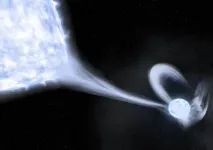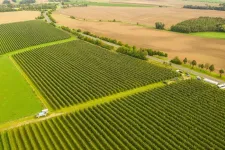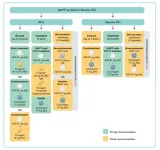(Press-News.org) UNDER EMBARGO UNTIL 19:00 GMT / 14:00 ET THURSDAY 14 DECEMBER 2023
Diverse gut bacteria communities protect against harmful pathogens by nutrient blocking
New study demonstrates that diverse communities of resident bacteria can protect the human gut from disease-causing microorganisms.
However, this protective effect is lost when only single species of gut bacteria are present.
The researchers found that protective communities block the growth of harmful pathogens by consuming nutrients that the pathogen needs.
The findings, published today in the journal Science, could help to develop new strategies to optimise gut health.
The human gut is home to hundreds of different bacterial species collectively known as the gut microbiome. A major health benefit these provide is to protect the gut against invading pathogens (disease-causing microorganisms) that could cause harmful infections. But up to now, how this protective effect comes about has been unclear, and whether certain bacterial species have a more important role than others.
To investigate this, researchers at the University of Oxford tested 100 different gut bacteria strains individually and in combination for their ability to limit the growth of two harmful bacterial pathogens: Klebsiella pneumoniae and Salmonella enterica. Individual gut bacteria showed a very poor ability to restrict the spread of either pathogen. But when communities of up to 50 species were cultured together, the pathogens grew up to 1000 times less effectively than when cultured with any individual species. This ‘community protection effect’ was seen regardless of whether the bacteria were cultured together in vials, or in ‘germ-free’ mice (which had no resident gut bacteria at the start of the experiments).
Author Professor Kevin Foster (Departments of Biology and Biochemistry, University of Oxford) said: ‘These results clearly demonstrate that colonization resistance is a collective property of microbiome communities; in other words, a single strain is protective only when in combination with others.’
However, the researchers found that the members of the bacterial communities – and not just the overall diversity – had a critical effect on the level of protection. Certain species were found to be essential for community-based protection, even though these species offered little protection on their own.
The researchers demonstrated that protective bacterial communities block pathogen growth by consuming the nutrients that the pathogen needs. By assessing the genomes of the different bacterial species, they found that the most protective communities were composed of species with highly similar protein compositions to the pathogenic species. They also used metabolic profiling to demonstrate that the protective species had similar demands for carbon sources as the pathogens.
Author Frances Spragge (Departments of Biology and Biochemistry, University of Oxford) added: ‘Crucially, although increased microbiome diversity increases the probability of protection against these pathogens, the overlap in nutrient utilization profiles between the community and the pathogen is key. Certain species that have a crucial role in community protection show a high degree of metabolic overlap with the pathogen, and therefore similar nutrient demands.’
The researchers used this nutrient blocking principle to predict communities of bacteria that would offer weak and strong protection against a different pathogen: an antimicrobial resistant E. coli strain. When tested experimentally, the communities which had the highest nutrient overlap with the E. coli strain were up to 100-fold more effective at reducing the pathogen’s abundance than the communities predicted to give weak protection.
According to the researchers, these new insights could be developed into novel strategies to combat harmful gut pathogens through optimising gut microbiome communities. They may also explain why individuals can become more susceptible to species such as K. pneumoniae after taking antibiotic treatments that can lower the diversity of gut microbiome species.
Author Dr Erik Bakkeren (Departments of Biology and Biochemistry, University of Oxford) added: ‘Our work supports the general hypothesis that a more diverse microbiome can carry health benefits. This gives promise to the goal of optimising the composition of microbiomes to protect against bacterial species that are harmful to health.’
Notes to editors:
For media enquiries and interview requests, contact: Professor Kevin Foster: kevin.foster@biology.ox.ac.uk
The study ‘Microbiome diversity protects against pathogens by nutrient blocking’ will be published in Science at 19:00 GMT/ 14:00 ET on Thursday 14 December at http://www.science.org/doi/10.1126/science.adj3502 DOI 10.1126/science.adj3502. This link will go live once the embargo lifts. To view a copy of the paper before this, see the Science Press Package at https://www.eurekalert.org/press/scipak/. If you have difficulties accessing this, please contact scipak@aaas.org
About the University of Oxford
Oxford University has been placed number 1 in the Times Higher Education World University Rankings for the eighth year running, and number 3 in the QS World Rankings 2024. At the heart of this success are the twin-pillars of our ground-breaking research and innovation and our distinctive educational offer.
Oxford is world-famous for research and teaching excellence and home to some of the most talented people from across the globe. Our work helps the lives of millions, solving real-world problems through a huge network of partnerships and collaborations. The breadth and interdisciplinary nature of our research alongside our personalised approach to teaching sparks imaginative and inventive insights and solutions.
Through its research commercialisation arm, Oxford University Innovation, Oxford is the highest university patent filer in the UK and is ranked first in the UK for university spinouts, having created more than 300 new companies since 1988. Over a third of these companies have been created in the past five years. The university is a catalyst for prosperity in Oxfordshire and the United Kingdom, contributing £15.7 billion to the UK economy in 2018/19, and supports more than 28,000 full time jobs.
END
Diverse gut bacteria communities protect against harmful pathogens by nutrient blocking
2023-12-14
ELSE PRESS RELEASES FROM THIS DATE:
Astronomers discover first population of binary stripped stars
2023-12-14
Astronomers at the University of Toronto have discovered a population of massive stars that have been stripped of their hydrogen envelopes by their companions in binary systems. The findings, published today in Science, shed light on the hot helium stars that are believed to be the origins of hydrogen-poor core-collapse supernovae and neutron star mergers.
For over a decade, scientists have theorized that approximately one in three massive stars are stripped of their hydrogen envelope in binary systems. Yet, until now, only one possible candidate had been identified.
“This was such a big, glaring hole,” says co-lead author ...
Ancient genomics and Indigenous Knowledge reveal history of Coast Salish “woolly dogs”
2023-12-14
DNA analysis of a 19th-century dog, paired with traditional knowledge acquired through interviews, have together provided new insights into the decline of Coast Salish “woolly dogs” – an extinct Indigenous dog once bred for its unique woolly coat. Dogs were introduced to the Americas at least 15,000 years ago and have been ubiquitous in Indigenous societies across the continents for thousands of years. Coast Salish peoples – a group of Indigenous societies that lived in the Salish Sea region of the Pacific Northwest (PNW) – kept several different types of dogs, including a special lineage of “woolly ...
Science’s 2023 Breakthrough of the Year: GLP-1 agonists show promise for obesity-associated health problems
2023-12-14
Science has named the development of glucagon like peptide-1 (GLP-1) agonists and this year’s discovery that these drugs can blunt obesity-associated health problems as its 2023 Breakthrough of The Year. Although obesity’s causes span genetic, physiological, environmental, and social factors, as a medical problem, obesity’s risks can be life-threatening – including heart disease, diabetes, arthritis, liver disease, and certain cancers. Drug treatments for obesity have had “a sorry past, one often intertwined with social pressure to lose weight and the widespread belief that excess weight reflects weak willpower,” writes ...
Using genomics to map illegal pangolin poaching from Africa to Asia
2023-12-14
Genomic analyses reveal illegal pangolin trafficking routes from origins in Africa to markets in Asia, researchers report. The approach offers new opportunities to monitor pangolin poaching in near real-time, allowing for targeted and more effective anti-trafficking measures. The illegal wildlife trade is a significant driver of global biodiversity loss. Of all the species poached and traded, the white-bellied pangolin (Phataginus tricuspis) is the world’s most trafficked mammal and is at risk of extinction. Pangolins are in high demand in Asia because their scales are believed, without scientific support, ...
Solar-powered clothes provide personal heating and cooling
2023-12-14
Combining a flexible solar cell with an electrocaloric device, researchers have created solar-powered clothing that allows the body to adapt dynamically to changes in ambient temperature, according to a new study. The new device could help guarantee the safety and comfort of the human body amid fluctuating environmental temperatures and even extend survivability in extreme environments, like those in outer space or other planets. Clothing is the most common way humans regulate their body temperature relative to the environment. However, it is normally focused on keeping an individual either warm or cool. The ability of clothing to ...
Reaching for the (invisible) stars
2023-12-14
Supernovae–stellar explosions as bright as an entire galaxy–have fascinated us since time immemorial. Yet, there are more hydrogen-poor supernovae than astrophysicists can explain. Now, a new Assistant Professor at the Institute of Science and Technology Austria (ISTA) has played a pivotal role in identifying the missing precursor star population. The results, now published in Science, go back to a conversation the involved professors had many years ago as junior scientists.
Some stars do not simply die down, but explode in a stellar blast that could outshine ...
How can Europe restore its nature?
2023-12-14
The ‘Nature Restoration Law’ (NRL) requires member states of the EU to implement restoration measures on at least 20 per cent of land and marine areas by 2030, and in all ecosystems in need of restoration by 2050. This includes specific targets to rewet peatlands and to increase pollinator populations. The NRL has already overcome various hurdles: most recently, it was approved by the EU Parliament’s Environment Committee, after delegations of the Parliament and the Council negotiated the final text.
But will the regulation really achieve its aims? The authors, including scientists leading large European projects on ...
Updated Canadian Cardiovascular Society Guidelines advise against routinely taking aspirin daily for primary prevention of heart attack or death but acknowledge there may be a role for some people
2023-12-14
Philadelphia, December 14, 2023 – The updated Canadian Cardiovascular Society (CCS)/Canadian Association of Interventional Cardiology (CAIC) antiplatelet therapy guidelines for primary and secondary prevention of atherosclerotic cardiovascular disease (ASCVD) provide recommendations based on the latest randomized evidence available in the literature. Updated by a panel of national experts, these new evidence-based guidelines appear in the Canadian Journal of Cardiology, published by Elsevier.
ASCVD, also known as ischemic heart disease (coronary artery ...
Rice study: AI provides more accurate analysis of prehistoric and modern animals, painting picture of ancient world
2023-12-14
A new Rice University study of the remains of prehistoric and modern African antelopes found that AI technology accurately identified animals more than 90% of the time compared to humans, who had much lower accuracy rates depending on the expert.
Composite images of teeth from five different antelope tribes analyzed and identified by artificial intelligence. Photo courtesy of Manuel Domínguez-Rodrigo.
Identifying these animals and their habits helps paint a broader picture of ancient ecosystems, and with the assistance of this new technology, it can be done with more speed and accuracy than previously done by paleontologists, ...
Working women feel unsupported by Christian congregations — even more progressive ones
2023-12-14
As church membership declines across the United States, a new study from Rice University’s Boniuk Institute for the Study and Advancement of Religious Tolerance finds that working women do not feel supported by their clergy and churches, regardless of whether they’re involved with a more conservative or liberal congregation.
“The Limits of Congregational Support for Working Women” is part of a larger study of faith at work funded by Lilly Endowment Inc. It ...



